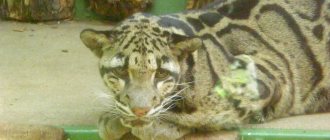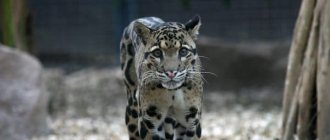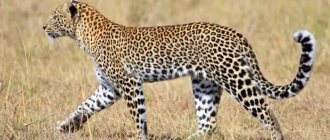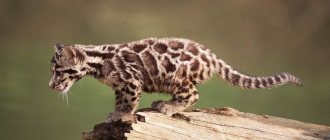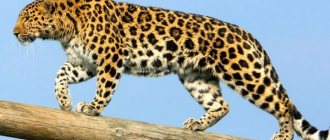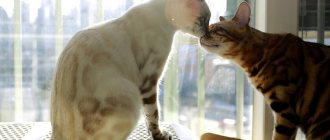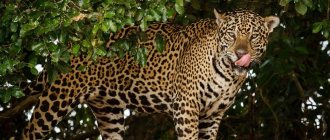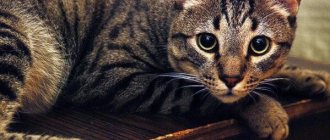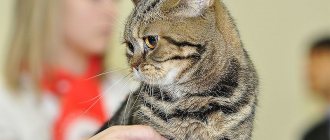Many people equate the beauty and grace of wild animals with the leopard. We suggest you find out how much a real live leopard costs in Russia from the material presented.
The leopard is one of the most beautiful representatives of the cat family. The individual belongs to the “big cats” subfamily, which is why the leopard is often called a panther. This animal is also known as the leopard. In Ancient Greece, these individuals were considered a cross between a panther and a lion.
Varieties
There are three classified subspecies of clouded leopards found in certain Asian regions:
- Neofelis nebulosa nebulosa - found from southern China to eastern Myanmar.
- Neofelis nebulosa macrosceloides - inhabits the territory from Nepal to Myanmar.
- Neofelis nebulosa brachyuran - lived in Taiwan, but is now considered extinct. The last time representatives of this subspecies were encountered was in 1989.
Spread range
Geographical distribution
Clouded leopards are found in Nepal, India, Myanmar, Thailand, Malaysia, Indochina and China south of the Yangtze River. A small number of these animals can also be found in the northeastern and southeastern parts of Bangladesh.
Photo: ISEC
The clouded leopard has been considered extinct in Nepal since 1863, according to studies published at the time. However, more than 100 years later, in 1987 and 1988, 4 individuals were discovered near Chitwan National Park.
Until recently, it was believed that the clouded leopard inhabited Borneo and Sumatra. However, genetic studies conducted in 2007 showed significant differences between the species. Therefore, the leopards found on the above islands are now considered a separate species, now classified as the Bornean clouded leopard (Neofelis diardi).
- Biogeographic regions: Southeast Asia
Habitat
Photo: Kate Ryan
Clouded leopards inhabit forested and mountainous areas at altitudes of up to 2,500 meters . These wild cats prefer dense evergreen tropical forests. Activity has also been recorded in the savannah, abandoned orchards, along streams and main paved roads. There is information about their residence in dry and secondary forests (previously cut down, but re-grown).
- Habitat: tropical, subtropical
- Terrestrial biomes: rainforest, mountain, bush, savanna or grassland
Home range
From 1998 to 2002, researchers conducted the first full-scale field study of clouded leopards. Two males and two collared cats were tracked for 7-17 months. Their annual habitat ranged from 22.9 to 51.9 square meters. km , and there was no difference in range sizes between the sexes. The cats covered an average of 1,932 meters per day and intensively used the central part of their range, an area of 3.6-8 square meters. km.
Photo: CBS Pittsburgh
A further study conducted in 2003 showed that the home ranges for females were already 22-25.7 square meters. km, and for males - 29.7-49.1 sq. km. Core habitats were smaller (3-5 sq km), possibly indicating greater prey abundance.
In both studies, male ranges overlapped with female ranges, and there was some evidence that male ranges overlapped as well.
Economic significance for humans
Positive
The Bornean clouded leopard is hunted illegally for its coat and various body parts used in traditional medicine. Tissue samples from dead clouded leopard carcasses have been used in phylogenetic studies that have helped establish the species' relationship with other members of the cat family.
Negative
The Kalimantan clouded leopard sometimes hunts livestock in villages surrounded by vast forests on the islands of Sumatra and Borneo. There are no records of Bornean clouded leopards attacking humans.
Character traits
Anatomical features
The clouded leopard has a long, slender body; elongated and rather narrow head with a wide muzzle; the ears are short and round. The limbs are relatively short and thick, which is considered exceptional among big cats. The feet are wide, like those of a jaguar. The hind legs are noticeably longer than the front legs, which allows the cat to make longer jumps.
Photo: Kate Ryan
Clouded leopards are the most talented climbers among the big cats. Their radius and ulna are not fused. Flexible ankle joints increase range of motion when climbing trees and stalking prey. Clouded leopards can climb down trees upside down , a trait common to margays from Central and South America.
They can hang from a branch, holding onto it only with their hind legs and tail, and remain in this position until they jump. Clouded leopards often use their tail to balance on thin branches.
The well-developed fangs of this wild cat also deserve attention, since according to some sources they can reach 3.5-4 cm in length. This is more than any other living cat.
Photo: Panthera.org
Because of their long upper canines compared to their body proportions, clouded leopards are called "modern saber-toothed cats" , a reference to the prehistoric saber-toothed tiger.
Coloring
The coat of the clouded leopard is predominantly light gray, less often brownish-gray, reddish or yellowish-brown. The lower part and inner side of the paws are lighter. The limbs, belly and head are covered with dark or black spots of irregular shape . There are two darker stripes on the back, and there are three on the neck. The ears are dark at the back, with white spots in the center. The long fluffy tail is edged with rings, the tip is black or dark gray.
Photo: Big Cats India
The nose pad is pink, sometimes with small black specks. The iris of the eye is brownish-yellow to grayish-green. The pupils narrow into vertical slits.
Dimensions
In terms of body length, clouded leopards are comparable to a lynx. However, their sexual dimorphism is weakly expressed: females are slightly smaller than males .
- Body length: from 81 to 108 cm (males), from 68 to 94 cm (females)
- Tail length: 74 to 91 cm (males), 61 to 82 cm (females)
- Shoulder height: 50 to 55 cm
- Body weight: from 16 to 21 kg (males), from 11 to 15 kg (females)
www.zoo-ekzo.ru – Exotic animals
Indian leopard (Panthera fusca)
Class - mammals Order - carnivores Family - felines
Subfamily - big cats
Genus - panthers
Appearance
A large cat, however, is significantly smaller in size than a tiger and a lion. The body is elongated, muscular, somewhat laterally compressed, light and slender, very flexible, with a long tail (its length is more than half the total length of the body). The legs are relatively short but strong. The front legs are powerful and wide. The head is relatively small and rounded. The forehead is convex, the facial parts of the head are moderately elongated. The ears are small, rounded, and set wide apart.
The eyes are small, the pupil is round. There is no mane or elongated hair on the upper part of the neck and on the cheeks (sideburns). Vibrissae are represented by black, white and half-black and half-white elastic hair up to 110 mm long.
The size and weight of leopards depend on the geographic area of their habitat and vary greatly. Individuals inhabiting forests are usually smaller and lighter, while those living in open areas are, on the contrary, larger than their forest counterparts. But on average, males are a third larger than females.
Body length without tail - 90 - 190 cm, (on average 160 cm) tail length 60 - 110 cm. Weight of females - 32 - 65 kg, males - 60 - 75 kg. The height of males at the withers is 50 - 78 cm. The height at the withers of the smallest individuals of females reaches only 45 cm.
The fur is uniform in length throughout the body, relatively short and close-fitting, not fluffy even in winter. The coat is coarse, thick, short. The leopard is characterized by a difference in the length and thickness of yellow and black (on spots) hair, with the former being thinner and longer.
The general color of the fur is light, the main background is yellow or red-yellow with small black spots forming ring shapes with a light center. These spots are of two types - solid or in the form of ring shapes - the so-called. "sockets". In the center of the latter there is a light field, more or less corresponding in color to the color of the main background of the fur. Black rings can be solid, but usually they are interrupted in 2-5 places and consist of 2-5 separate spots grouped into a ring. The largest annular spots, as a rule, have a diameter of up to 50 - 65 mm. The outlines of the spots are usually sharp. There are no transverse (vertical) stripes in the color, but sometimes individual spots on the back can merge into short longitudinal stripes.
The general tone of fur color when comparing different subspecies varies from pale straw or gray to rusty brown. Young leopards are somewhat lighter in color - the main background of the fur is grayish-yellow, sometimes off-white.
The general color tone varies geographically and individually, and also changes by season. In leopard subspecies living in the northern regions of the world range, the fur background varies from relatively dull light yellow or yellowish-grayish to bright yellowish-red with a golden tint, but can also be light gray and almost white and whitish. The degree of coloring is most intense on the back, partly on the upper side of the neck and head. On the sides of the body, the brightness and intensity of the color of the general background gradually brightens, losing yellow and red tones. On the belly, along the inside of the limbs, on the throat and along the underside of the neck, at the ends of the paws, along the underside of the tail, in the end half it becomes white.
The front part of the leopard's muzzle is devoid of spots, only in the area of the whiskers there are small marks and a dark spot in the corner of the mouth. On the cheeks, on the forehead, between the eye and ear, on the top and sides of the neck there are predominantly small solid black spots; on the upper side of the neck they are somewhat elongated. The back of the ears is black. Ring spots are located on the back and sides of the animal’s body, and along the ridge they usually have an elongated shape or form a pattern consisting of large elongated ring and solid spots. The ring spots are located on the sides of the leopard's body, above the shoulder blades and on the thigh. If the ring spots on the sides extend down to the belly, then they usually constitute the predominant type of spots. Solid dark spots on the skin of a leopard are located on all parts of the body where ring spots are absent, but they are also present in greater or lesser quantities along with ring spots. The limbs and belly of the leopard are covered with continuous spots. The spots located on the outer side of the legs are large at the top, and become smaller downwards; on the hands and feet they are only small specks. The tail is covered above, partially and below with large ring or solid spots.
The degree and nature of spotting is variable. Usually the spots are pure black, but they can also be brownish. The total number and density of spots may also vary. African leopards have small spots, while Asian subspecies have larger ones. The shape of solid spots, the size of ring spots, the number of their constituent elements, as well as the color of their internal field (corresponds to the color of the main background or darker) are variable.
The pattern of spots is unique to each individual animal, and thus can be used to identify individuals, similar to fingerprints in humans. This feature is sometimes used by researchers to identify individual individuals in the wild that are being monitored. The main function of this coloration is to camouflage the predator when hunting.
Individual variability in the color of leopards as a whole is manifested only by changes in the color intensity of the main background of the fur and variations in the spotted pattern.
In Southeast Asia, there are melanistic leopards, which are called black panthers (from the Greek pánther). The skin of a black panther is not completely black; more or less visible spots are always visible on it. Dark fur perfectly camouflages them in dense forest thickets. They are especially common in Java. The recessive gene responsible for melanism is much more common in leopard populations living in forested and mountainous areas, as well as in leopards from tropical Asia. On the Malay Peninsula, almost half of all leopards are black; in other places the prevalence of melanism is much lower.
Black individuals can be born in the same litter with normally colored cubs. Typically, panthers are more aggressive than other leopards.
Incomplete melanism or pseudo-melanism (“abundism”) is a condition in which increased pigmentation of the skin or other integuments does not occur uniformly, but in separate areas, also occurs among leopards. With abundism, the spots expand until they merge. Abundism, like melanism, is most often the result of mutations.
The claws are light, waxy in color, compressed on the sides, strongly curved, very sharp. The length along the outer arc reaches 55 mm on the front legs. The claws on the hind feet are smaller and not as sharp.
There is no sexual dimorphism as such, and sexual differences are expressed only in the smaller body size and lighter structure of the skull of females.
Habitat
The leopard's range is wider than that of any other member of the cat family, with the exception of the domestic cat. The plasticity of the species is explained by its secretive lifestyle and its ability to hunt a wide variety of animals.
Inhabits forest, partly forest-steppe regions, savannas and mountainous regions of Africa and the southern Anterior and southern half of East Asia.
In nature
This is a solitary, predominantly nocturnal animal. Leopards are easily adaptable and live in forests, mountains and even deserts, with the area of an individual range varying from 8 to 400 km² depending on the region, topography and abundance of prey. Despite its relatively small size, the leopard is capable of hunting large prey weighing up to 900 kilograms.
The leopard is an excellent climber in trees, often settling there for a daytime rest or in ambush, and sometimes even catching monkeys in trees. However, the leopard mainly hunts on the ground. It quietly sneaks up on its prey within a jumping distance. Jumps on prey and strangles it, but if unsuccessful, does not pursue. There were cases when the leopard did not sneak up on the prey, but rather deliberately spanked with its paws so that the prey heard it, then became silent and, therefore, the prey did not know exactly where it was. He drags the remains of large prey up a tree to protect it from hyenas, jackals and other necrophages.
The leopard feeds mainly on ungulates: antelopes, deer, roe deer and others, and during periods of starvation - rodents, monkeys, birds, and reptiles. Sometimes attacks domestic animals (sheep, horses). Like a tiger, he often kidnaps dogs; Foxes and wolves suffer from it. It does not disdain carrion and steals prey from other predators, including other leopards.
A leopard very rarely attacks a person without being disturbed by him, but always does this when wounded. The results of his attack can have fatal consequences for the hunter. Among leopards, man-eaters are less common than among lions and tigers.
Leopards hunt alone, using, like other types of big cats, two main hunting techniques: sneaking up on prey and waiting for it in ambush. To prevent hyenas from getting their prey, leopards drag it into the trees.
Reproduction
In the southern areas of their habitat, leopards breed all year round. In the Far East, estrus occurs in late autumn - early winter. Like other cats, it is accompanied by fights and loud roars of the males, although in normal times the leopard rarely gives a voice, being more silent than the lion and tiger.
After a 3-month pregnancy, 1-2, rarely 3, blind cubs appear. Their lair is caves, crevices, holes under upturned tree roots in a remote, secluded place. Young leopards grow noticeably faster than tiger cubs and after 2.5 years they reach full growth and sexual maturity, with females slightly earlier than males.
Captive
In captivity, leopards are kept in a spacious enclosure. The enclosure is a metal structure up to 3 meters high, closed on three sides and on top with a strong lattice or mesh, and on the fourth side the wall should be made of strong boards, covered with tin for strength. There should be a “house” attached to it - a refuge for the animal in bad weather and a place where it is closed during cleaning.
The door to the steel sheet enclosure must be opened using a cable system.
The minimum area of an enclosure for a leopard should be 40 square meters, and the minimum size of the house should be 2x2m. The house must be insulated. It should be dry and clean. The house must be covered with straw. Southern subspecies require a heated house, since their weak undercoat does not protect their body from severe frosts.
The enclosure is fenced with metal reinforcement, the rods of which should be located at a distance of 10 cm. The floor is made of concrete, asphalt, and wood. Veterinarians do not advise leaving the floor earthen, as this will lead to the accumulation of helminths on its surface.
The enclosure should be equipped with wooden shelves and trees.
Leopards should be fed once a day, with one fasting day per week.
The main food of leopards is lean meats, such as beef, lamb, poultry and rabbit. Once a week you can add raw eggs to the meat. To improve digestion, give vegetable oil, grain sprouts and bran. “Live food” is required - killed rabbits, chickens, etc.
You need to feed according to the following scheme: 4 days - meat, 2 days a week - live food. A leopard is given 3.5 kg of meat and bones per day.
It is necessary to monitor the cleanliness of the water in the drinking bowl. It is necessary to wash the drinking bowl and change the water to fresh water daily.
To maintain the health of leopards, they are regularly given vitamins F, E, A and D3, bone meal - a source of calcium, and yeast containing B vitamins. This is especially necessary for growing kittens.
To maintain good physical shape, predators need movement, which should be provided by hanging a piece of meat on a rope. You also need to provide some “toys” for the animals in the enclosure: durable balls, inner tubes, ropes and driftwood.
Life expectancy in captivity is up to 21 years
Eating habits
Because there is little information available on clouded leopards, very little is also known about their diet. Most likely, they hunt animals that live in trees and the ground.
Despite their carnivorous diet , clouded leopards also eat plants and bird eggs.
The massive body and long tusks allow it to kill even large prey, including wild boars, deer, goats, monkeys, gophers, birds and reptiles. They guard their prey, hiding among the dense branches of trees, and suddenly jump on the victims from above.
Nutrition
The clouded leopard spends a lot of time on tree branches, so it is quite natural that the basis of its menu consists of birds, monkeys, and sometimes palm civets.
The leopard is very dexterous, so it is quite capable of catching prey while sitting on a tree. But this does not mean that he ignores larger game - he quite often feeds on goats, and can also catch a young buffalo, deer or pig.
If a reptile comes across, it manages to catch fish or other living creatures - it will eat them too. Thanks to binocular vision, a leopard can hunt at any time of the day, which distinguishes it very favorably from its relatives, and indeed from many predatory animals. Wide, strong paws and long fangs serve him well.
The leopard tracks its prey while sitting on a tree or hiding on the ground. Due to the peculiarities of the structure of the jaw and the location of the long fangs, the cat can kill the victim with one correct bite. In search of food, it travels about 1-2 kilometers per day and can swim across water obstacles.
Each leopard has its own hunting grounds, the size of which is about 30-45 km. in males, and slightly less in females. Moreover, areas of different-sex individuals may overlap slightly.
Leopards in captivity receive the food necessary for carnivores, but in addition, zookeepers pamper these fluffy cats with treats - popsicles in the form of large pieces of papaya with ice.
Lifestyle
Early observations showed that this is a very secretive animal, leading a nocturnal lifestyle. However, later studies based on camera trap data partially refuted the previous conclusions of zoologists. It turns out that clouded leopards are active both during the day and at night. They are less active at midday, but dusk and the pre-dawn hours are theirs at any time of day.
Photo: Shady Ramzy
The clouded leopard spends most of its time in trees. It rests in the trees until dark and then descends to the ground to hunt wild boar and muntjac, which usually go to bed after sunset.
Clouded leopards lead a solitary lifestyle . This is another reason why they are difficult to observe. The habits of these animals probably depend on the presence of other predators and the proximity of human settlements.
Behavior
Little information is known regarding the general behavior of the Kalimantan clouded leopard. Most likely, they are solitary animals, like many other big cats, except during breeding or raising offspring. The Bornean clouded leopard was previously thought to be completely nocturnal. However, the latest data shows activity throughout the day.
There is little data regarding the average home range of Bornean clouded leopards. Lately, single males have been photographed by camera traps over an area of 45 km². However, the average home range size is believed to be larger than the data. Based on this limited amount of information, the home range of the Kalimantan clouded leopard is larger than that of the mainland species. Additional camera trap research estimated the average range size per male to be 112 km², indicating low population densities in this region of its geographic range.
Communication and perception
Photo: Kate Ryan
Clouded leopards, like lions, tigers and other big cats, cannot purr . However, their range of vocalizations is very wide and includes: meows, hisses, growls, groans and snorts. When two individuals approach each other, they communicate using an acoustic communication channel. When in a friendly mood, they make quiet, low-frequency snorting sounds. Clouded leopards, tigers, snow leopards and jaguars are the only cats that use this type of vocalization.
Sometimes they emit a drawn-out moaning call, clearly distinguishable over long distances . This is a warning sign for other cats to stay away from their territory, and perhaps a call to mate.
Like other felines, clouded leopards have keen eyesight, sense of smell and hearing. They mark their home range by marking their territory using urine, scent glands, and scratching trees.
Reproduction
In captivity, clouded leopards become sexually mature approximately two years after birth, and their first mating season is between March and August. However, individuals living in the wild often do not have a clearly defined reproductive season.
During the rut, the male makes a loud sound and grabs the female by the neck . The receptive female responds to the male with a loud sound, encouraging him to continue mating. After copulation, the pair separates, and the male does not take any part in raising the offspring.
Pregnancy lasts about 86-95 days. The female gives birth to one to five cubs (usually three) in a den built in dense vegetation.
Photo: Florida's Paradise Coast
Like other big cats, newborns are blind and completely defenseless. They weigh from 140 to 280 grams. The cubs open their eyes 10 days after birth, begin to walk at 19-20 days and climb trees at 6 weeks of age. They try chewing solid food at about 10 weeks, but continue to breastfeed until five months.
Kittens are covered with yellowish-gray fur at birth, with full adult coloration acquired at approximately six months. Independence from the mother occurs by ten months.
- Breeding interval: 10 to 16 months
- Breeding season: Can occur all year round
- Average number of offspring: 2-3 cubs
- Gestation period: 12-13.5 weeks
- Weaning time: 10 to 14 weeks
- Average time to independence: 9-10 months
- Age of sexual or reproductive maturity: 23-24 months (females), 23-26 months (males)
Save Status
Clouded leopards are still widely hunted for their fangs and ornamental skin, as well as for their bones, which are sought after in the Asian folk medicine market. In Sarawak, their long tusks are used by some tribes as ear ornaments. Clouded leopard meat is also featured on the menus of respectable restaurants in Thailand and China catering to wealthy Asian tourists. Poachers capture live animals for the illegal pet trade. Massive deforestation of tropical forests, the native habitat of clouded leopards, also poses a threat.
Threats
The Kalimantan clouded leopard is a large predator and has very few natural enemies. They are hunted illegally by people for their beautiful coats, as well as some body parts that are used in traditional medicine. In Sumatra, clouded leopards coexist with tigers, but there is no confirmed information regarding the threat from their larger relatives. During most of the daylight hours, these animals remain at altitude, apparently to avoid tigers. They are very well camouflaged, which likely helps reduce the risk of predation.
Did you know?
- The oldest individual in captivity lived to be 17 years old, although their average lifespan is usually 11 years.
- It is estimated that the entire clouded leopard population consists of only 10,000 individuals .
- The natives of Taiwan believe that the clouded leopard is their spiritual ancestor, who brought them to their homeland.
- Clouded leopards are sacred to some indigenous peoples of Southeast Asia. Malaysians call them "tree cats" due to their preference for resting on tree branches. The Chinese call them "mint leopards" because their spots remind them of mint leaves. Unfortunately, none of these names have helped protect these wild cats from poachers.
- The clouded leopard's fur pattern is reminiscent of the marbled cat, which is also found in southeastern Asia.
